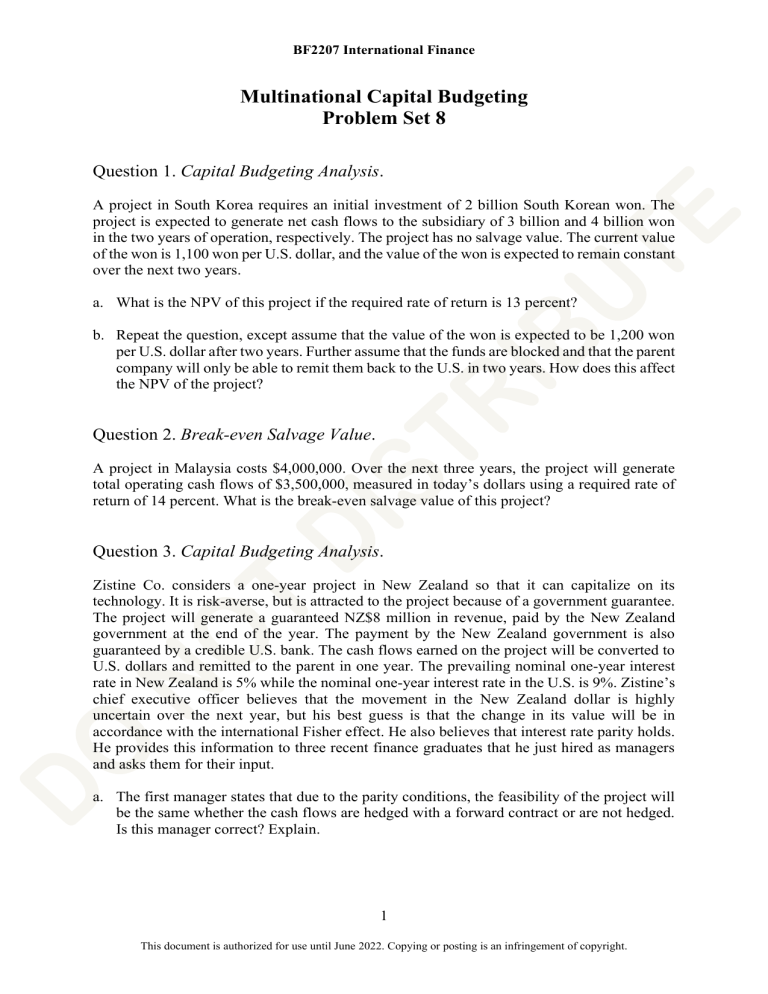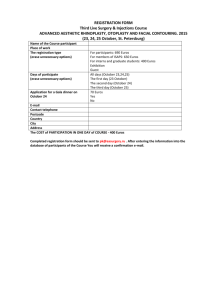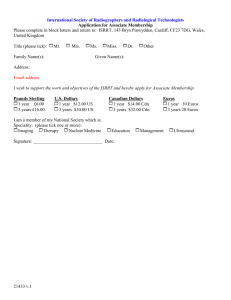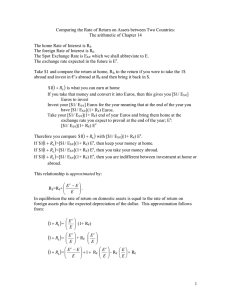
BF2207 International Finance Multinational Capital Budgeting Problem Set 8 Question 1. Capital Budgeting Analysis. A project in South Korea requires an initial investment of 2 billion South Korean won. The project is expected to generate net cash flows to the subsidiary of 3 billion and 4 billion won in the two years of operation, respectively. The project has no salvage value. The current value of the won is 1,100 won per U.S. dollar, and the value of the won is expected to remain constant over the next two years. a. What is the NPV of this project if the required rate of return is 13 percent? b. Repeat the question, except assume that the value of the won is expected to be 1,200 won per U.S. dollar after two years. Further assume that the funds are blocked and that the parent company will only be able to remit them back to the U.S. in two years. How does this affect the NPV of the project? Question 2. Break-even Salvage Value. A project in Malaysia costs $4,000,000. Over the next three years, the project will generate total operating cash flows of $3,500,000, measured in today s dollars using a required rate of return of 14 percent. What is the break-even salvage value of this project? Question 3. Capital Budgeting Analysis. Zistine Co. considers a one-year project in New Zealand so that it can capitalize on its technology. It is risk-averse, but is attracted to the project because of a government guarantee. The project will generate a guaranteed NZ$8 million in revenue, paid by the New Zealand government at the end of the year. The payment by the New Zealand government is also guaranteed by a credible U.S. bank. The cash flows earned on the project will be converted to U.S. dollars and remitted to the parent in one year. The prevailing nominal one-year interest rate in New Zealand is 5% while the nominal one-year interest rate in the U.S. is 9%. Zistine s chief executive officer believes that the movement in the New Zealand dollar is highly uncertain over the next year, but his best guess is that the change in its value will be in accordance with the international Fisher effect. He also believes that interest rate parity holds. He provides this information to three recent finance graduates that he just hired as managers and asks them for their input. a. The first manager states that due to the parity conditions, the feasibility of the project will be the same whether the cash flows are hedged with a forward contract or are not hedged. Is this manager correct? Explain. 1 This document is authorized for use until June 2022. Copying or posting is an infringement of copyright. Multinational Capital Budgeting b. The second manager states that the project should not be hedged. Based on the interest rates, the IFE suggests that Zistine Co. will benefit from the future exchange rate movements, so the project will generate a higher NPV if Zistine does not hedge. Is this manager correct? Explain. c. The third manager states that the project should be hedged because the forward rate contains a premium, and therefore the forward rate will generate more U.S. dollar cash flows than the expected amount of dollar cash flows if the firm remains unhedged. Is this manager correct? Explain. Question 4. Capital Budgeting With Hedging. Baxter Co. considers a project with Thailand s government. If it accepts the project, it will definitely receive one lump sum cash flow of 10 million Thai baht in five years. The spot rate of the Thai baht is presently $0.03. The annualized interest rate for a 5-year period is 4% in the U.S. and 17% in Thailand. Interest rate parity exists. Baxter plans to hedge its cash flows with a forward contract. What is the dollar amount of cash flows that Baxter will receive in five years if it accepts this project? Question 5. Capital Budgeting and Financing. Cantoon Co. is considering the acquisition of a unit from the French government. Its initial outlay would be $4 million. It will reinvest all the earnings in the unit. It expects that at the end of 8 years, it will sell the unit for 12 million euros after capital gains taxes are paid. The spot rate of the euro is $1.20 and is used as the forecast of the euro in the future years. Cantoon has no plans to hedge its exposure to exchange rate risk. The annualized U.S. risk-free interest rate is 5% regardless of the maturity of the debt, and the annualized risk-free interest rate on euros is 7%, regardless of the maturity of debt. Assume that interest rate parity exists. Cantoon s cost of capital is 20%. It plans to use cash to make the acquisition. a. Determine the NPV under these conditions. b. Rather than use all cash, Cantoon could partially finance the acquisition. It could obtain a loan of 3 million euros today that would be used to cover a portion of the acquisition. In this case, it would have to pay back a lump sum total of 7 million euros at the end of 8 years to repay the loan. There are no interest payments on this debt. This financing deal is structured such that none of the payment is tax-deductible. Determine the NPV if Cantoon uses the forward rate instead of the spot rate to forecast the future spot rate of the euro, and elects to partially finance the acquisition. [You need to derive the 8-year forward rate for this question.] 2 This document is authorized for use until June 2022. Copying or posting is an infringement of copyright. Multinational Capital Budgeting Question 6. Sensitivity of NPV to Conditions. Burton Co., based in the U.S., considers a project in which it has an initial outlay of $3 million and expects to receive 10 million Swiss francs (SF) in one year. The spot rate of the franc is $0.80. Burton Co. decides to purchase put options on Swiss francs with an exercise price of $0.78 and a premium of $0.02 per unit to hedge its receivables. It has a required rate of return of 20 percent. a. Determine the net present value of this project for Burton Co. based on the forecast that the Swiss franc will be valued at $0.70 at the end of one year. b. Assume the same information in part (a), but with the following adjustment. While Burton expected to receive 10 million Swiss francs, assume that there were unexpected weak economic conditions in Switzerland after Burton initiated the project. Consequently, Burton received only 6 million Swiss francs at the end of the year. Also assume that the spot rate of the franc at the end of the year was $0.79. Determine the net present value of this project for Burton Co. if these conditions occur. Question 7. Hedge Decision on a Project. Carlotto Co. (a U.S. firm) will definitely receive 1 million British pounds in one year based on a business contract it has with the British government. Like most firms, Carlotto Co. is risk averse and only takes risk when the potential benefits outweigh the risk. It has no other international business, and is considering various methods to hedge its exchange rate risk. Assume that interest rate parity exists. Carlotto Co. recognizes that exchange rates are very difficult to forecast with accuracy, but it believes that the one-year forward rate of the pound yields the best forecast of the pound s spot rate in one year. Today the pound s spot rate is $2.00, while the one-year forward rate of the pound is $1.90. Carlotto Co. has determined that a forward hedge is better than alternative forms of hedging. Should Carlotto Co. hedge with a forward contract or should it remain unhedged? Briefly explain. Question 8. NPV of Partially Hedged Project. Sazer Co. (a U.S. firm) is considering a project in which it produces special safety equipment. It will incur an initial outlay of $1 million for the research and development of this equipment. It expects to receive 600,000 euros in one year from selling the products in Portugal where it already does much business. In addition, it also expects to receive 300,000 euros in one year from sales to Spain, but these cash flows are very uncertain because it has no existing business in Spain. Today s spot rate of the euro is $1.50 and the one-year forward rate is $1.50. It expects that the euro s spot rate will be $1.60 in one year. It will pursue the project only if it can satisfy its required rate of return of 24 percent. It decides to hedge all the expected receivables due to business in Portugal, and none of the expected receivables due to business in Spain. Estimate the net present value (NPV) of the project. 3 This document is authorized for use until June 2022. Copying or posting is an infringement of copyright. Multinational Capital Budgeting Question 9. Project Financing Strategy. Konk Co., a U.S. firm, considers a project in which it would build a subsidiary in Belgium that would generate net cash flows of about 10 million euros per year for 5 years and would remit that amount to the parent each year. It has no other international business. It needs about 20 million euros as the initial outlay to establish the subsidiary. It can finance this initial outlay in the following ways and the subsidiary would repay the amount of the investment evenly over the next 5 years: (a) the parent can borrow dollars from a U.S. bank and convert them to euros, (b) the parent can borrow euros from a Belgian bank, (c) the parent can use its equity (retained earnings from existing business in the U.S.) and convert the funds into euros, (d) the parent can borrow dollars from a Belgian bank and convert them to euros, and (e) the parent can diversify its financing by obtaining one-fourth of the funds from each of the preceding sources. Assume that there is no cost advantage to any financing method. If Konk Co. wants to use a financing method to minimize its project s exposure to exchange rate risk, which method should it use? Briefly explain. Question 10. NPV and Financing. Louisville Co. is a U.S. firm considering a project in Austria which it has an initial cash outlay of $7 million. Louisville will accept the project only if it can satisfy its required rate of return of 18 percent. The project would definitely generate 2 million euros in one year from sales to a large corporate customer in Austria. In addition, it also expects to receive 4 million euros in one year from sales to other customers in Austria. Louisville s best guess is that the euro s spot rate will be $1.26 in one year. Today, the spot rate of the euro is $1.40, while the one-year forward rate of the euro is $1.34. If Louisville accepts the project, it would hedge all the receivables resulting from sales to the large corporate customer, and none of the expected receivables due to expected sales to other customers. a. Estimate the net present value (NPV) of the project. b. Assume that Louisville considers alternative financing for the project, in which it would use $5 million cash, and the remaining initial outlay would come from borrowing euros. In this case, it would need 1,600,000 euros to repay the loan (principal plus interest) at the end of one year. Assume no tax effects due to this alternative financing. Estimate the NPV of the project under these conditions. c. Do you think the Louisville s exposure to exchange rate risk due to the project if it uses the alternative financing (explained in part b) is higher, lower, or the same as if it has an initial cash outlay of $7 million (and does not borrow any funds)? Briefly explain. 4 This document is authorized for use until June 2022. Copying or posting is an infringement of copyright.





